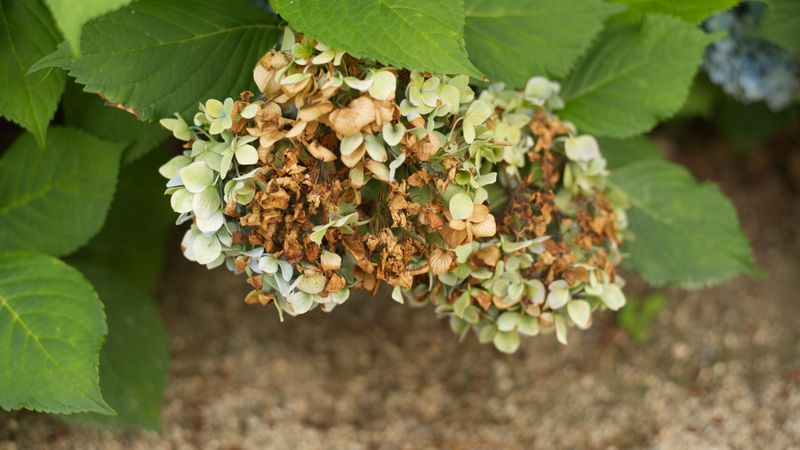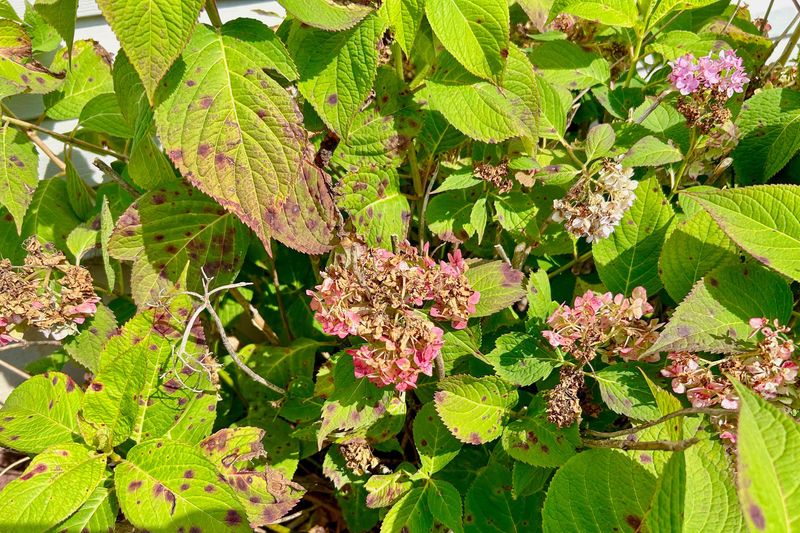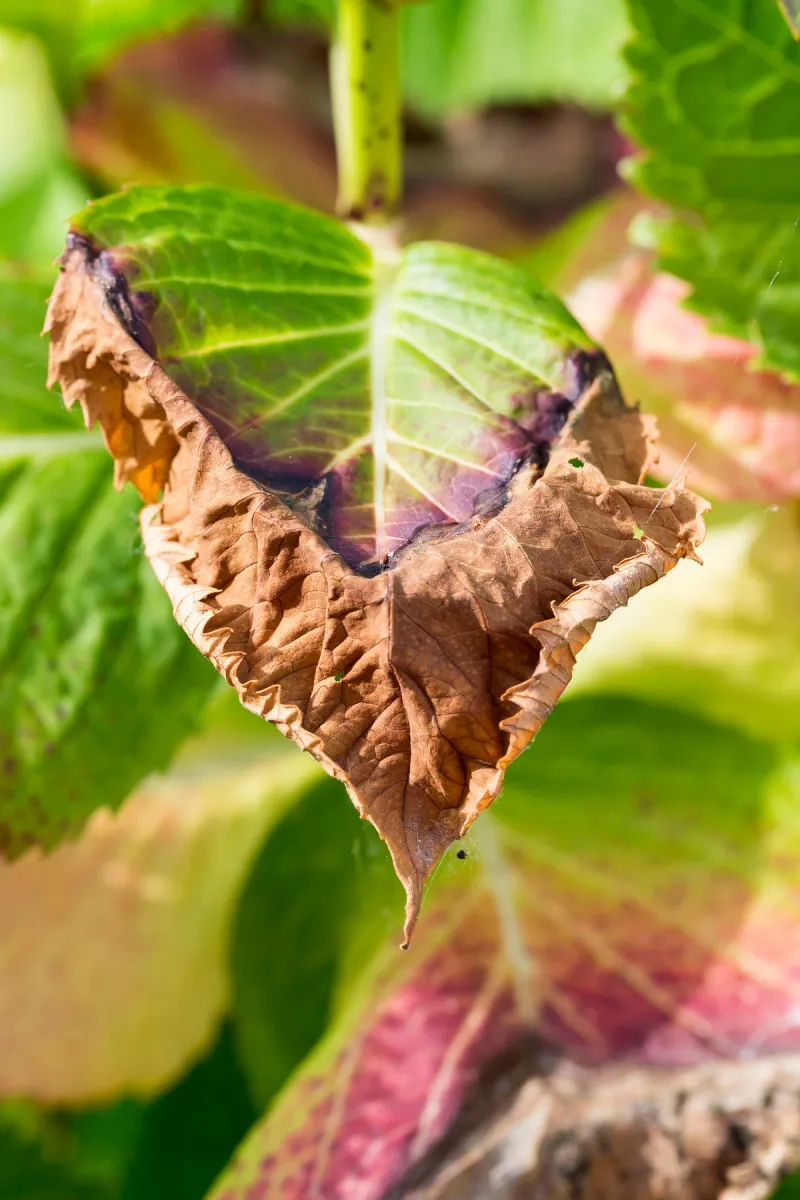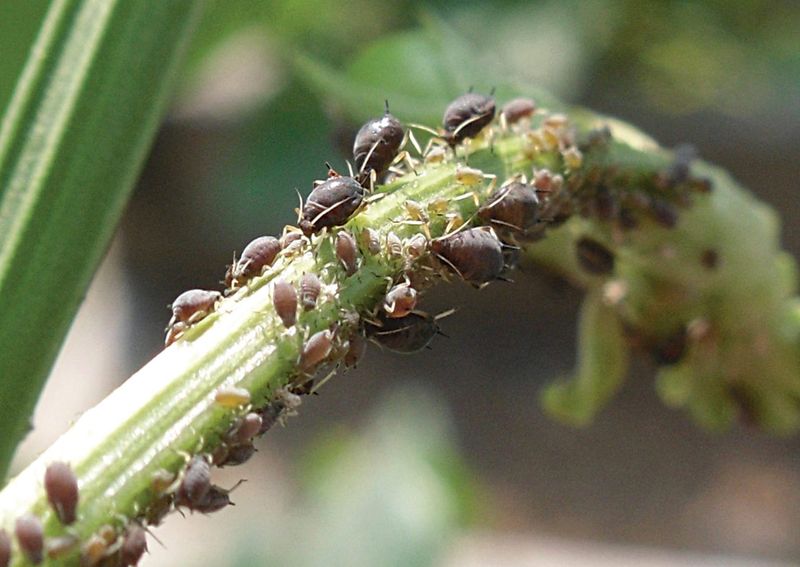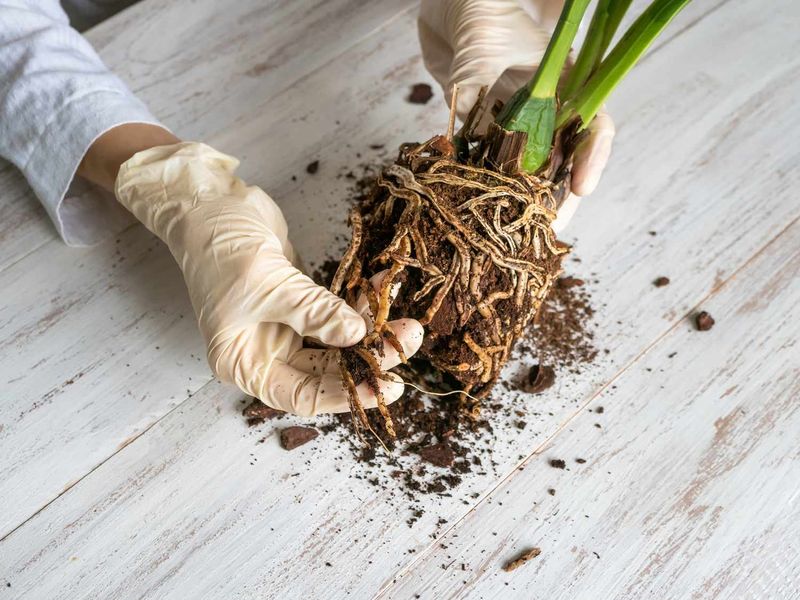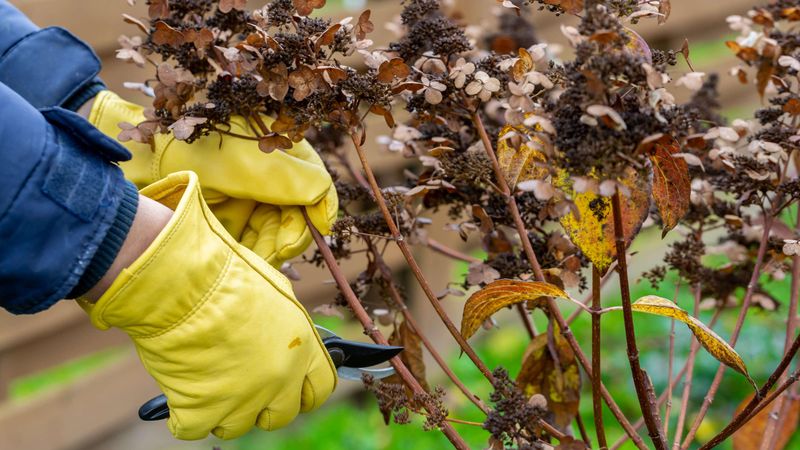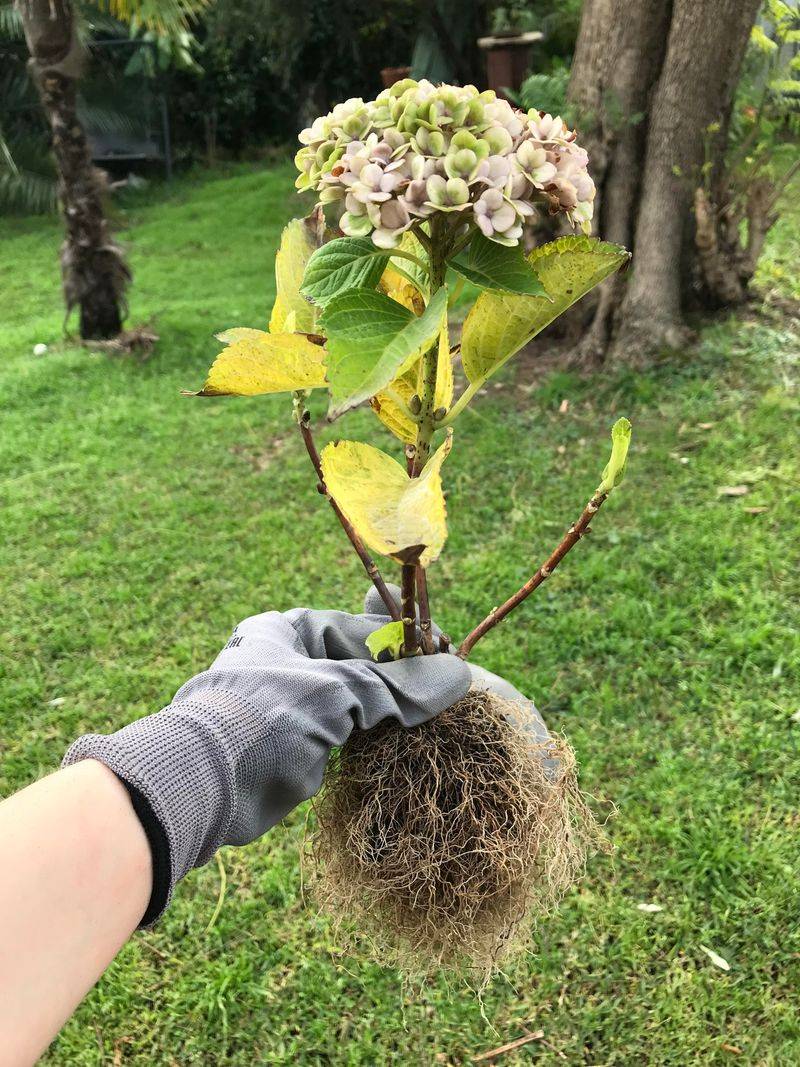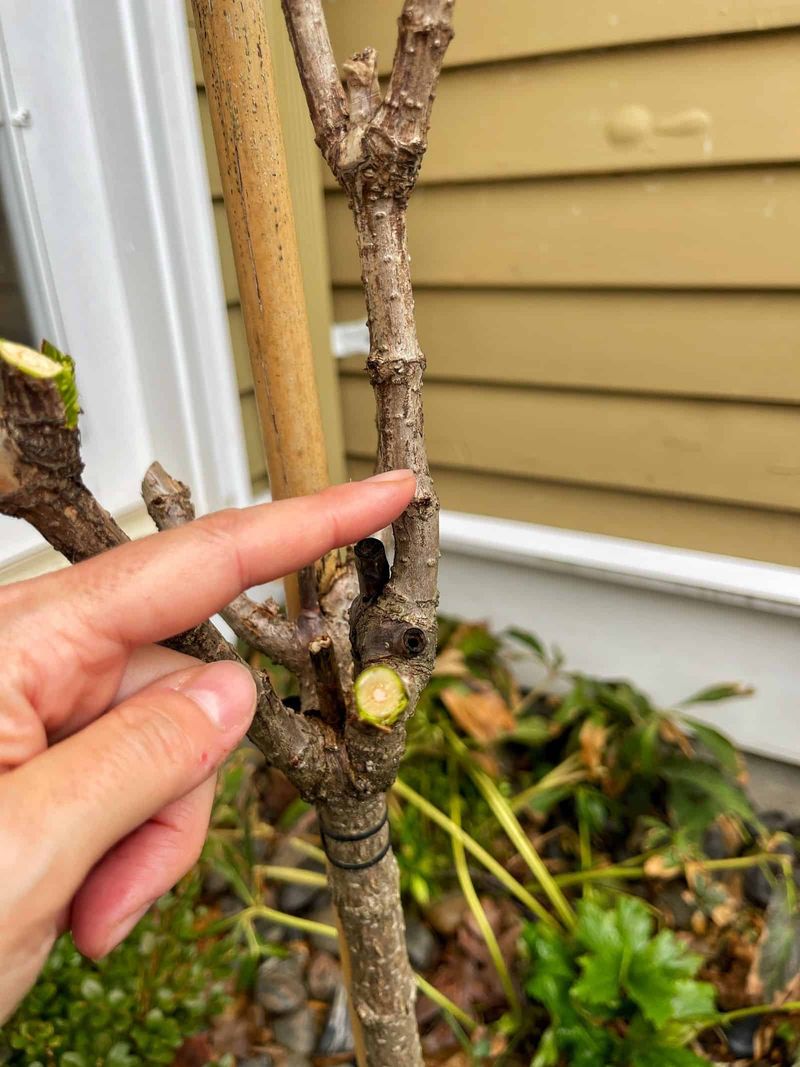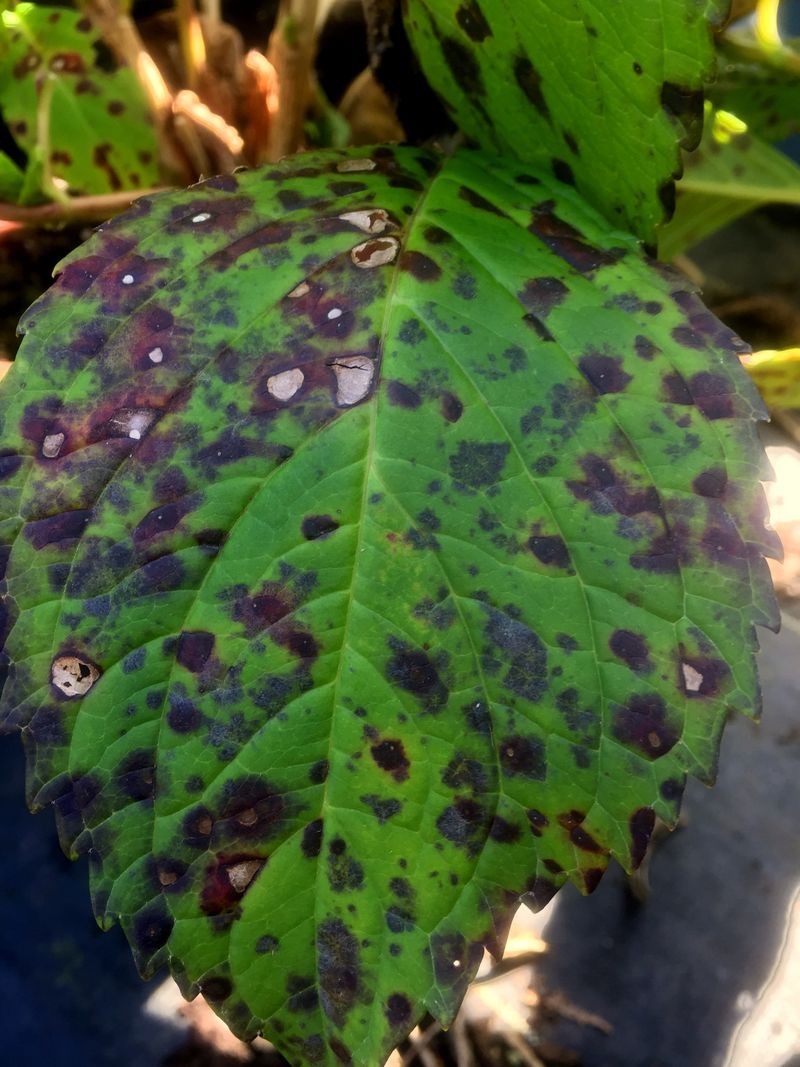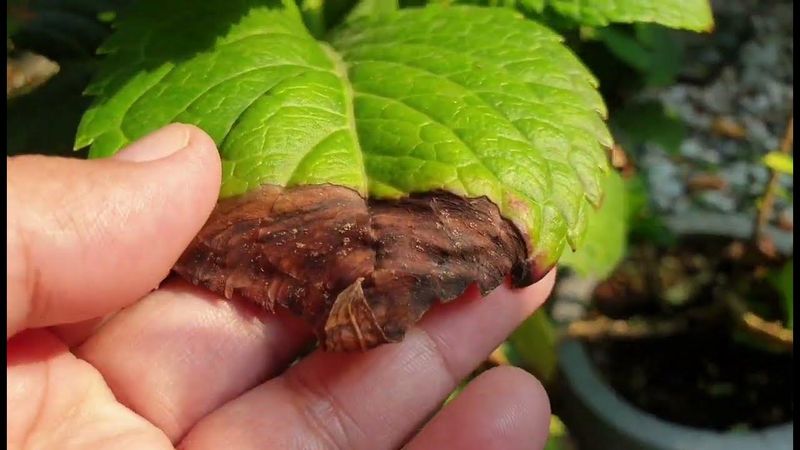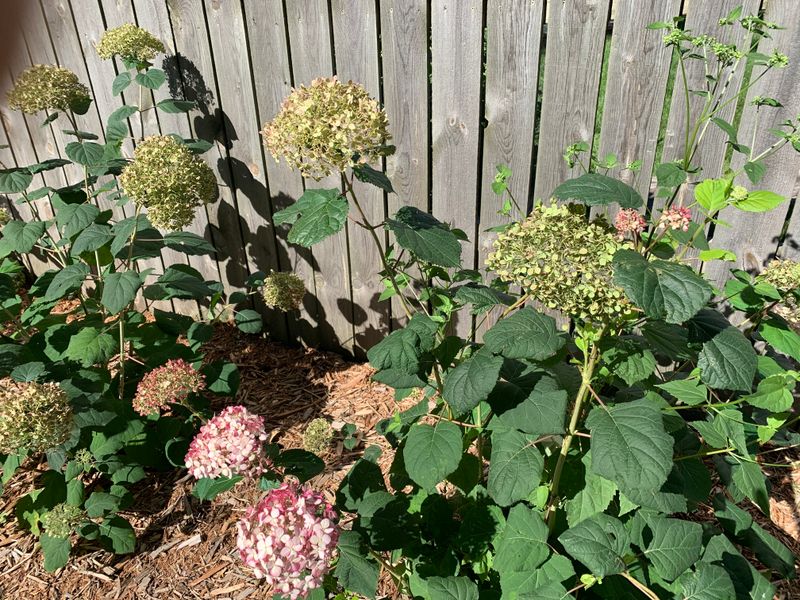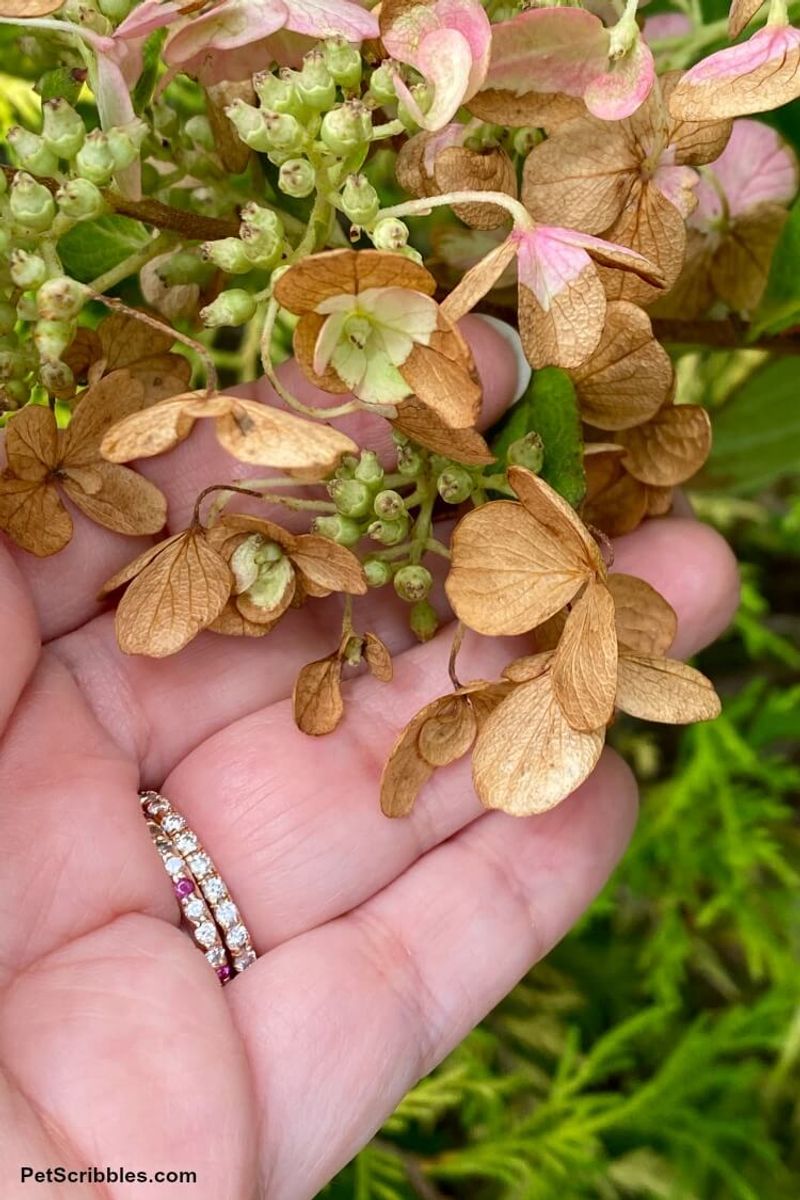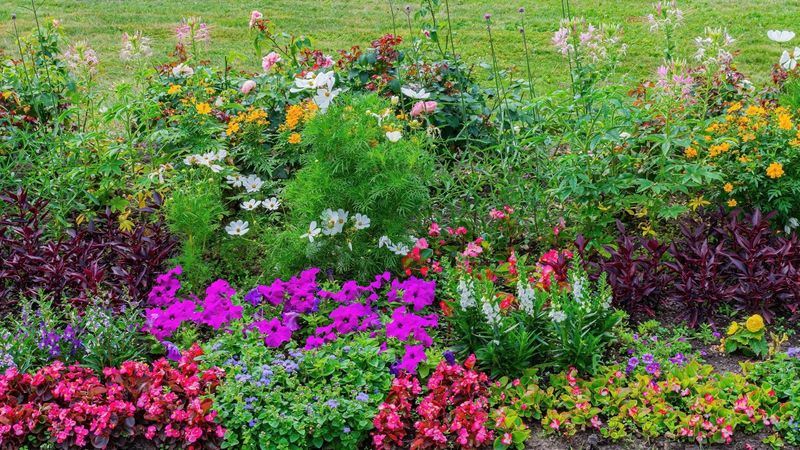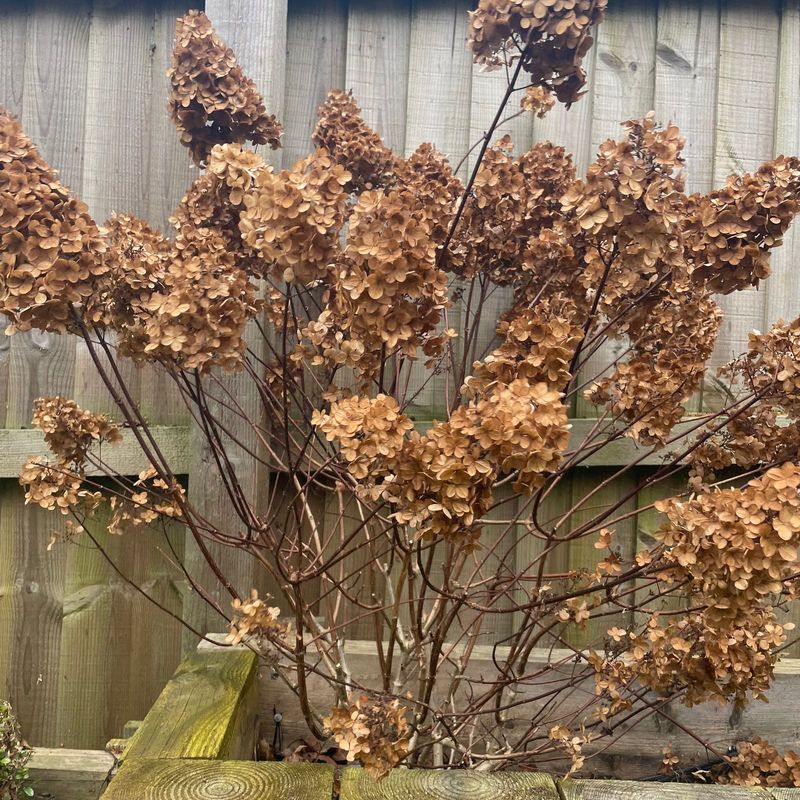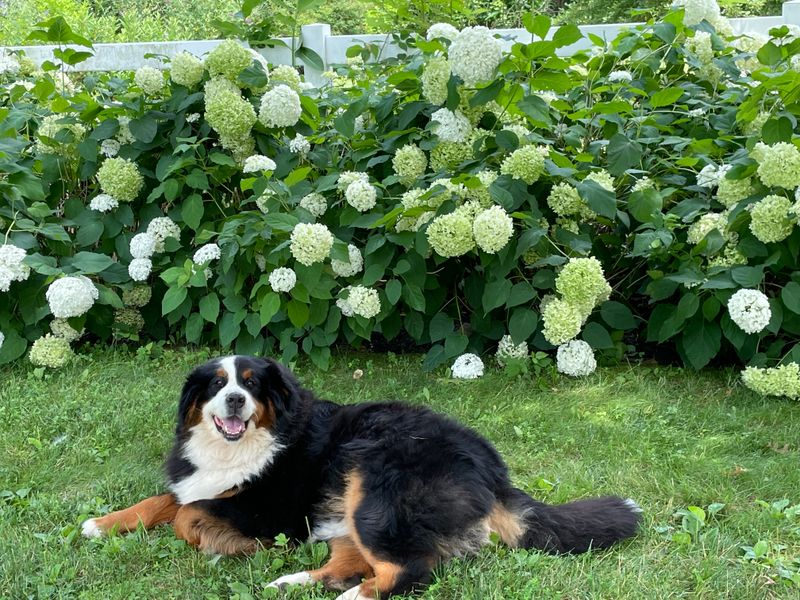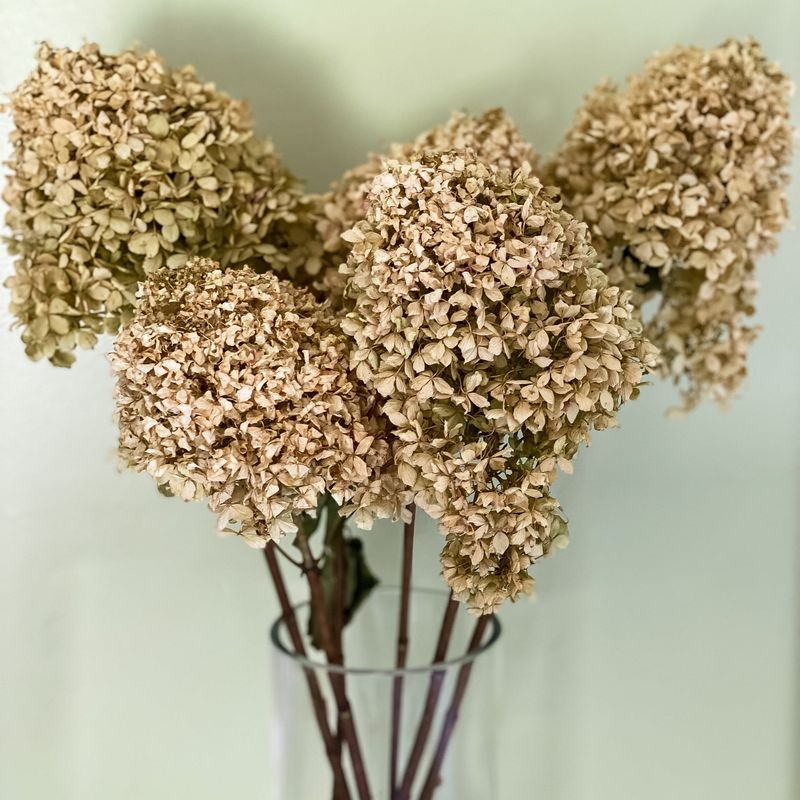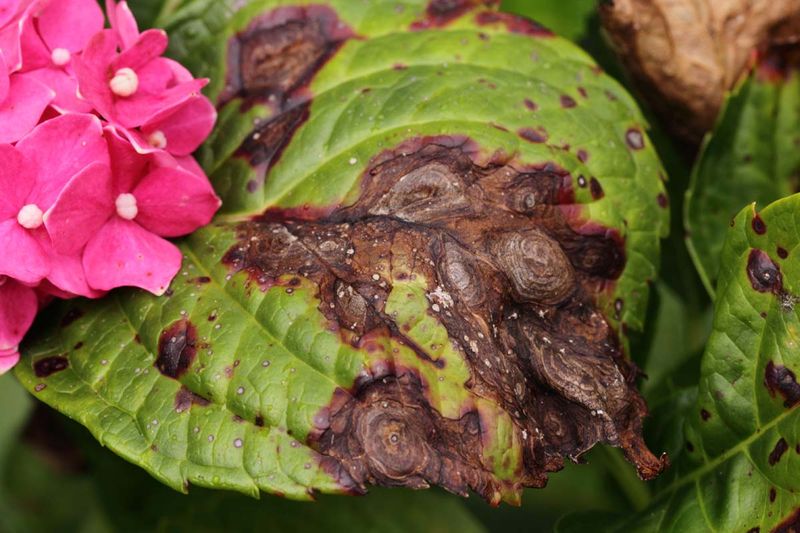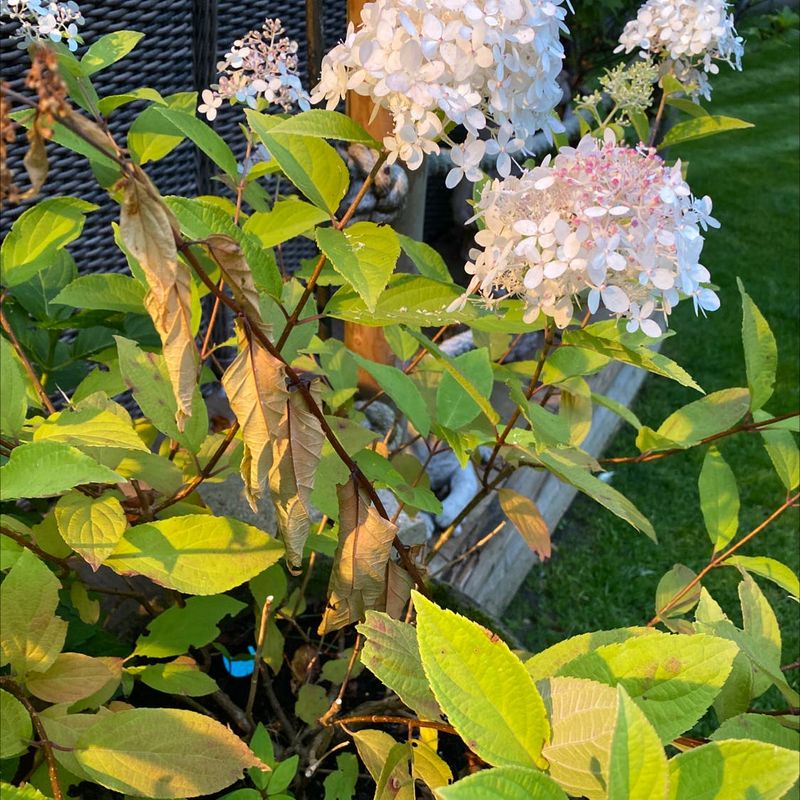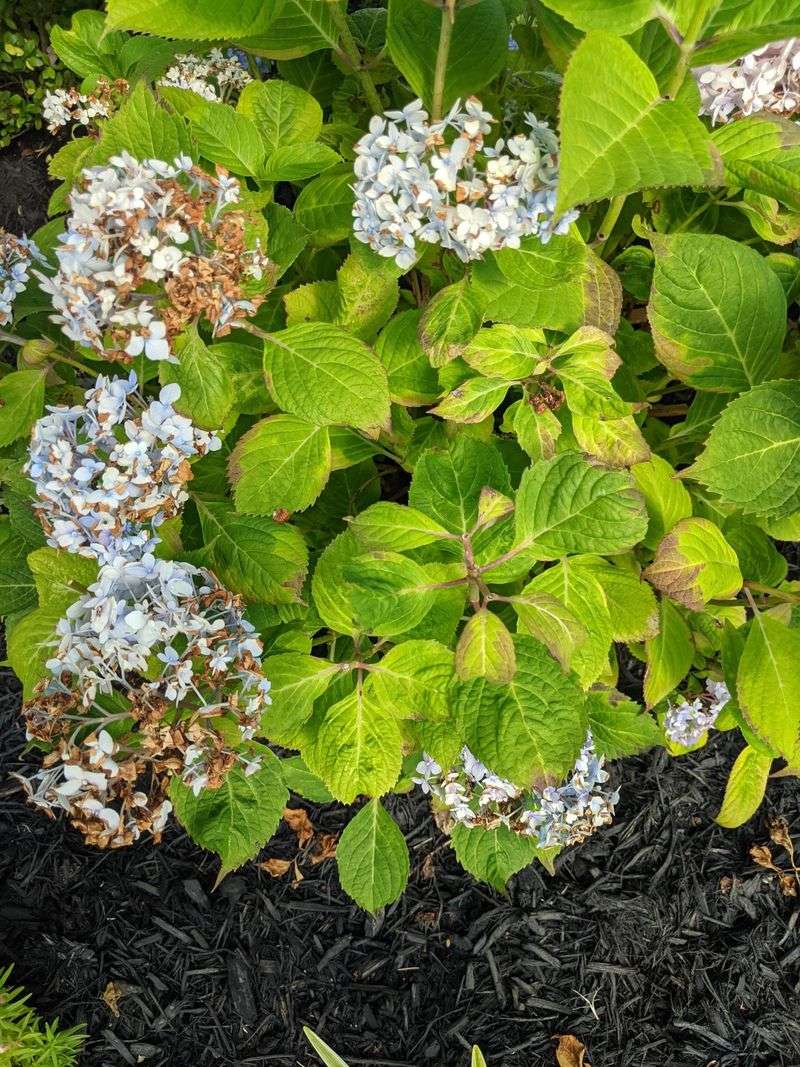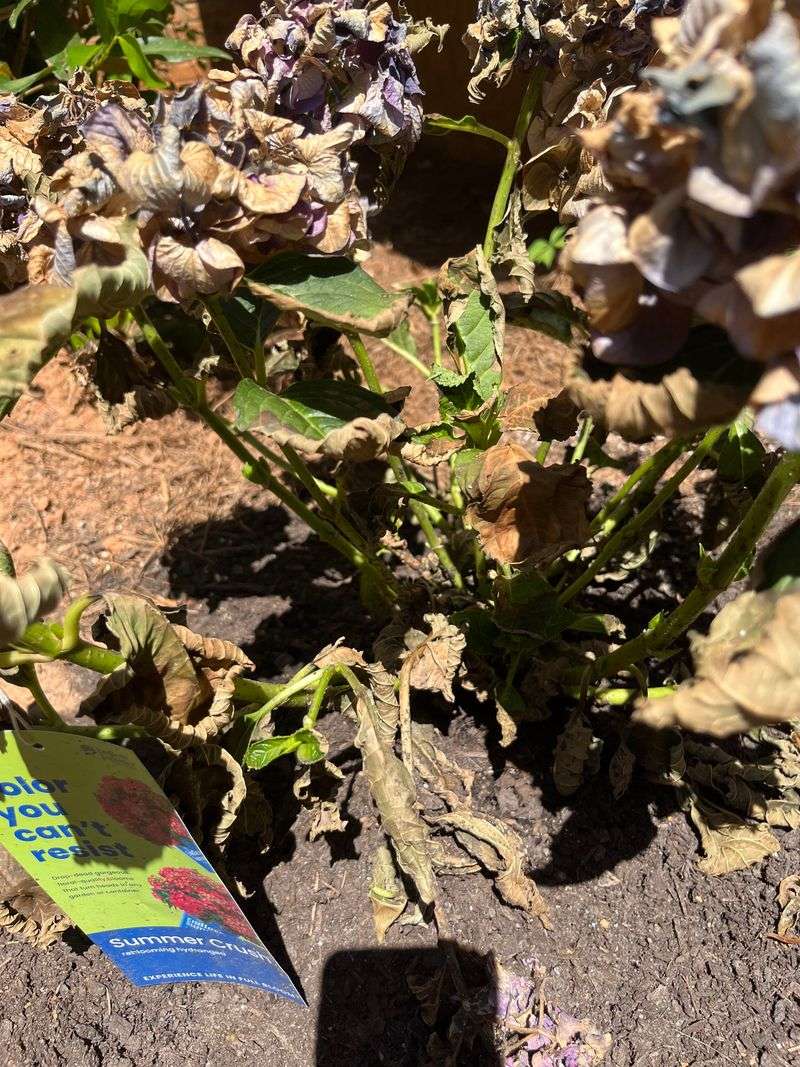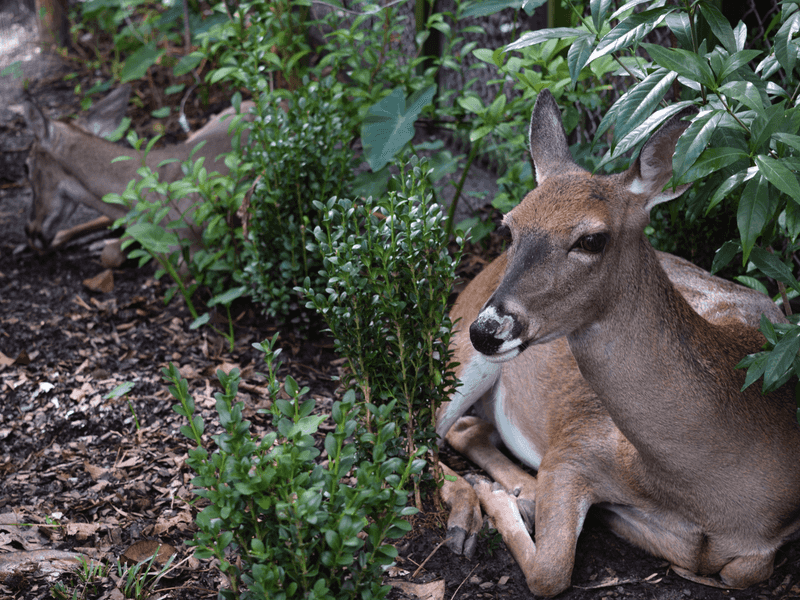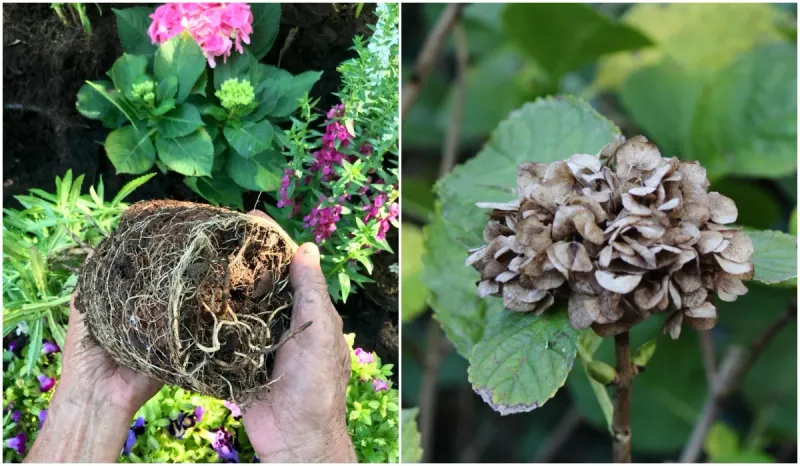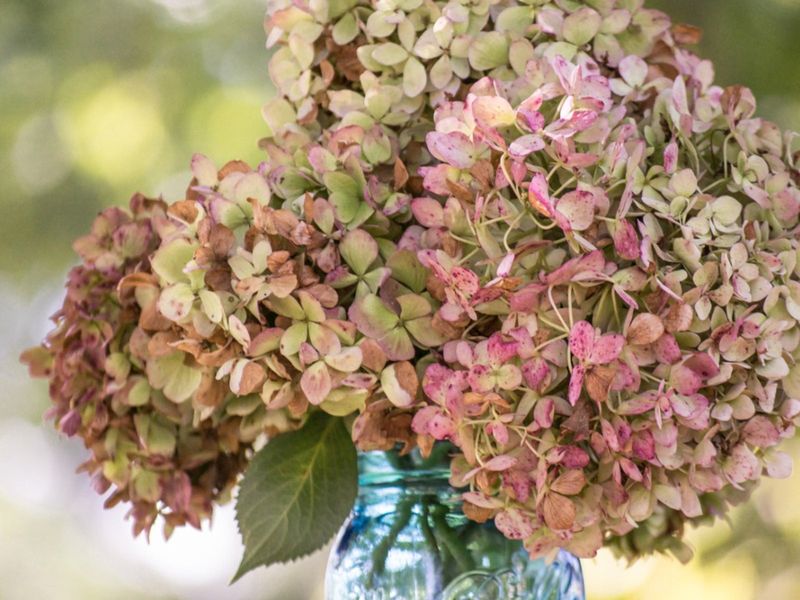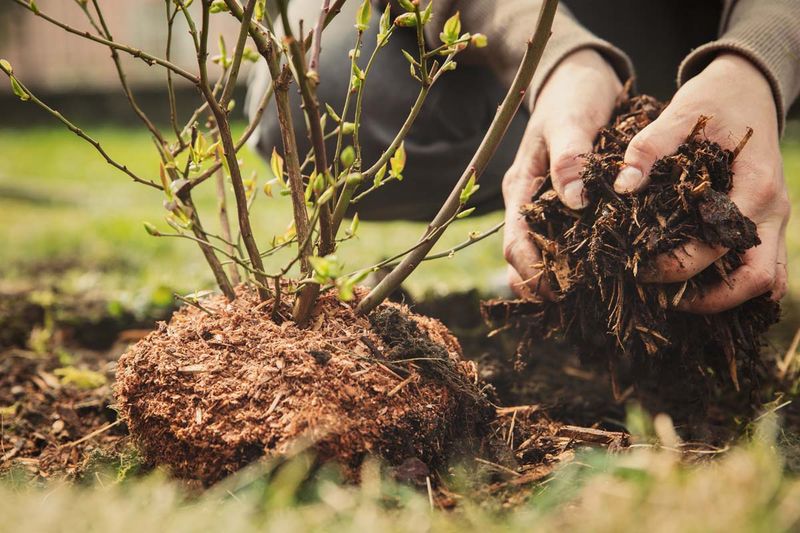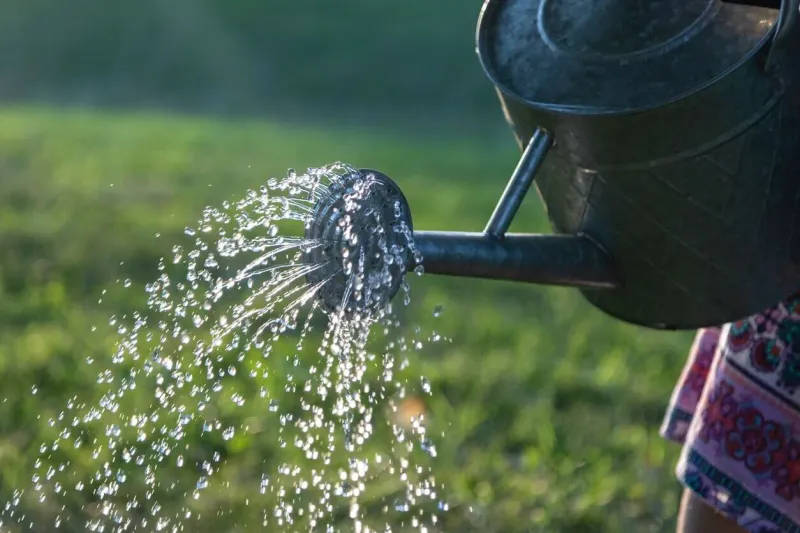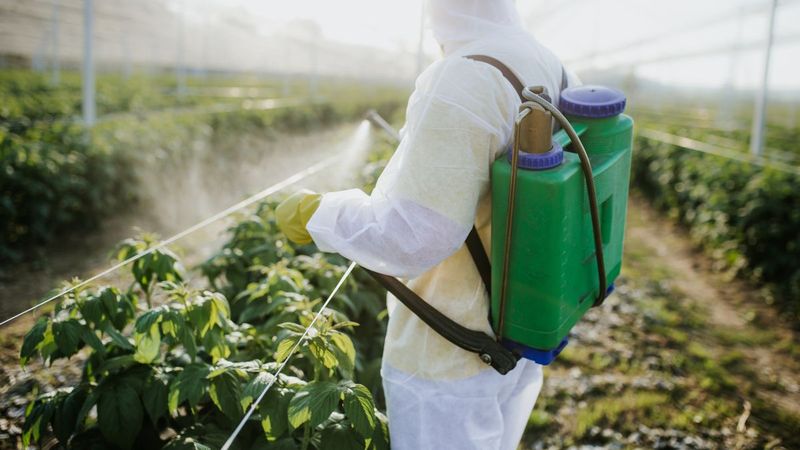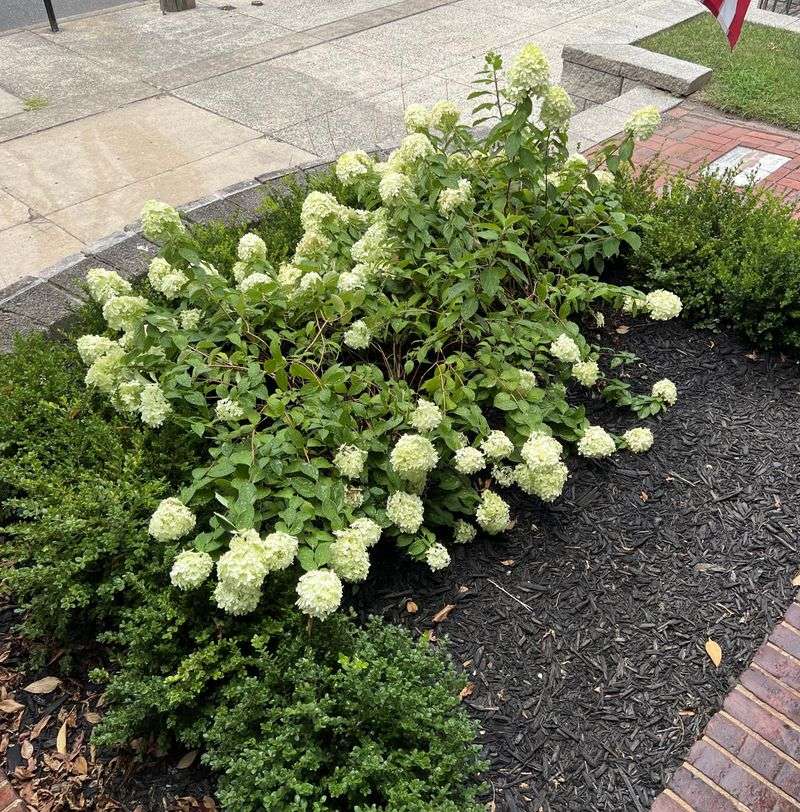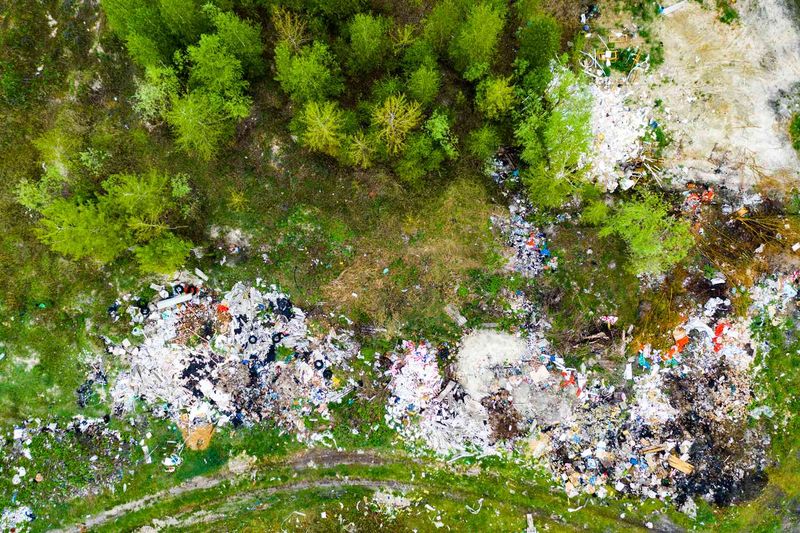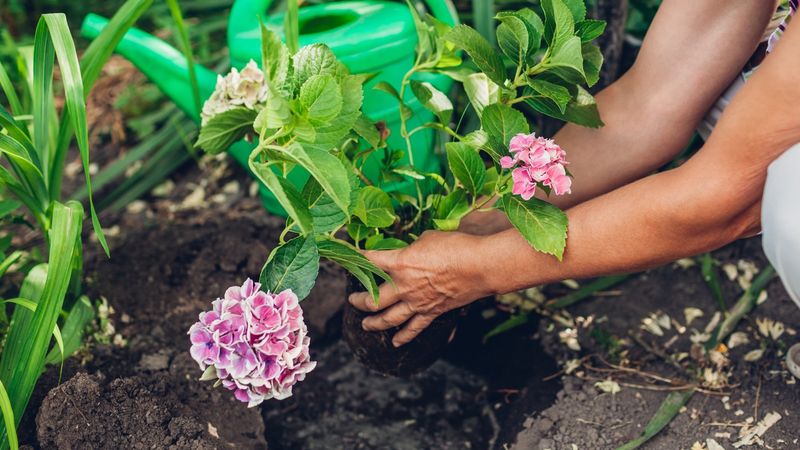Hydrangea blooms are more than just pretty garden decorations—they’re like little reminders of nature’s resilience and the cycle of life.
I still remember the first time mine bloomed. But here’s the funny part: I totally forgot I’d pruned them a bit too hard that year, and I was convinced they’d never come back.
Fast forward to summer, and there they were, bursting with blooms, proving me wrong. It felt like they were saying, We’ve got this!
Every time they flower, it’s like a mini celebration of nature’s persistence, and I can’t help but admire how they bounce back year after year.
1. Water Stress
Is the soil too dry or too wet? That’s the riddle here. Your blooms react dramatically to water stress, either by wilting or browning. It’s like a hydrangea soap opera, and the soil moisture is the villain.
Keep the drama low by ensuring consistent watering. Over-watering can be just as harmful as drought. The soil should be moist but not swampy.
Imagine the morning dew, not a marshland. Monitoring and adjusting your watering routine can prevent this melodrama from unfolding in your garden.
2. Sun Exposure
I thought they’d love full sun, and I proudly set them up in a sunny spot. Big mistake. The poor leaves started turning brown, and I felt like I’d ruined them.
It was like I left my favorite cake in the oven too long! After some research, I moved them to a spot with morning sunlight and afternoon shade.
It was like they sighed in relief. Now, they bloom beautifully, and every time I see them thrive, I know I’ve found their sweet spot!
3. Nutrient Deficiency
Is your soil lacking essential nutrients? This could be the reason your blooms are not their usual lively selves. Hydrangeas need a balanced diet of nitrogen, phosphorus, and potassium.
Think of it as their daily multivitamin. Brown edges on leaves often signal a deficiency. Conduct a soil test to identify missing nutrients and amend the soil accordingly.
A well-fed hydrangea equals blooms. Fertilize appropriately, but don’t overdo it. Moderation is key to avoiding another set of issues.
4. Pest Infestation
Uninvited guests can ruin any party, even in your garden! Pests like aphids and spider mites suck the joy out of your hydrangeas, leaving behind damaged leaves.
They’re like the party crashers of the plant world. Regular inspection is crucial. If you spot these critters, act swiftly with insecticidal soap or neem oil.
Natural predators can also keep these pests in check. It’s a battle, but with vigilance, your blooms can bounce back and reclaim their glory.
5. Root Rot
Hidden beneath the soil, root rot is a silent but deadly threat. This condition arises from overwatering or poorly drained soil, creating a breeding ground for fungi.
It’s the dark secret of many a gardener. Detecting it early is vital. A mushy base or weak stems are warning signs.
Improve drainage by adding organic matter to your soil and adjust your watering schedule. Rescuing your plants involves cutting back on water and even replanting if needed. Fight the rot before it spreads.
6. Cold Damage
Winter is coming, and it’s not always kind. Cold damage can manifest as blackened or browned leaves, a chilling sight indeed. It’s like your hydrangeas caught a winter cold.
Protect them by mulching the base to retain warmth. During harsh frosts, covering them with burlap can offer additional protection.
Consider this your plant’s winter coat. By preparing in advance, you can prevent the frost from nipping at your beloved blooms.
7. Soil pH Imbalance
Soil pH can be a sneaky saboteur. An imbalance might make it challenging for hydrangeas to absorb necessary nutrients, leading to discolored flowers and leaves.
Imagine a picky eater refusing their greens. Test your soil to determine its pH level. Adjusting the acidity or alkalinity with lime or sulfur can restore harmony.
Your flowers thrive on a balanced diet, so don’t let pH imbalance spoil their meal. A little chemistry goes a long way.
8. Improper Pruning
Pruning my hydrangeas has definitely taught me that it’s more of an art than a chore! I remember getting a little too eager with the pruning, thinking I was helping, but ended up giving them a bad haircut.
The poor plants took forever to bounce back, and the browning leaves were a clear sign I’d overdone it. I’ve since learned that timing and technique are everything.
Now, I prune gently in the right season, using sharp shears for clean cuts, and my hydrangeas reward me with fuller, healthier blooms. A little patience and precision go a long way!
9. Fungal Infections
Fungi are opportunists, waiting for the perfect damp conditions to invade. They leave behind unsightly spots and browning edges. It’s as if your plants caught a contagious rash.
Improve air circulation by spacing plants adequately and pruning excess foliage. Fungicides can help, but prevention is your best ally.
By keeping things dry and airy, you reduce the chances of fungi gaining a foothold. It’s about outsmarting the little invaders before they settle in.
10. Chemical Burns
Oops, that fertilizer or pesticide might have been a tad too strong. Chemical burns leave hydrangeas with scorched leaves, a reminder of overzealous gardening.
Think of it as a plant sunburn, but self-inflicted. Careful application and correct dilution of chemicals can prevent this mishap. Always read labels and follow instructions.
Spot test on a small area before full application. Your plants deserve care, not a chemical onslaught. Prevention is definitely better than cure when it comes to your blooms.
11. Improper Planting
Planting depth, it matters more than you’d think. Too shallow or too deep, and your hydrangeas might struggle to establish. It’s like wearing shoes that don’t fit and are uncomfortable and problematic.
Ensure the root ball is level with the ground. Consider spacing too; they need room to breathe. Correct placement gives your plants a better chance to flourish.
Think of it as setting the stage for a grand performance. Get it right from the start to avoid future issues.
12. Salt Damage
Road salt is a silent winter menace. It can accumulate on roadside plants, causing leaves to brown and shrivel. Just like how too much salt is bad for us, it’s no different for plants.
If your hydrangeas are near roads, rinse them to remove any salty residue. A strategic placement away from salted areas can prevent damage.
Shield your plants with burlap or barriers if necessary. Taking these steps keeps salt from becoming a destructive force.
13. Overcrowding
I learned the hard way that overcrowding is like throwing a party where no one has enough space to dance. At first, I planted my hydrangeas too close together, thinking they’d create a full look.
But before long, I noticed the leaves turning brown and a general sense of struggle among my plants. It was like a botanical traffic jam!
I decided to give them some breathing room, thinning out the crowded spots. Now, they have space to grow, get enough sunlight, and show off their beautiful blooms.
14. Inappropriate Climate
Living in the wrong climate is tough, even for plants. Hydrangeas prefer temperate climates, and extreme conditions can stress them.
It’s like wearing a winter coat in summer. If your region isn’t ideal, consider moisture-retaining mulches and regular watering. Selecting the right species for your climate can also make a world of difference.
Adaptability is key, but knowing your environment helps your plants thrive. Don’t fight nature; work with it for a garden that flourishes.
15. Mechanical Damage
Oops! Accidental damage from lawnmowers or pets can lead to broken stems and browning leaves. It’s like a toddler’s enthusiastic embrace, often more harm than good.
Be mindful when working in the garden. Barriers or strategic planting can protect your hydrangeas from such mishaps. Prune damaged areas to encourage new growth.
Awareness and care prevent these accidents, keeping your garden pristine and thriving. Your blooms deserve a safe space to grow and flourish.
16. Seasonal Changes
Autumn heralds changes, and your hydrangeas are no exception. Leaves turn color, with some browning naturally. This isn’t a cause for alarm, but a part of their life cycle.
It’s like changing wardrobes with the seasons. Prepare your garden for winter by mulching and pruning. Protecting the base and roots ensures plants are ready to bounce back come spring.
Embrace the transformation and know it’s a sign of renewal. Seasons shift, and so do the hues of your blooms.
17. Disease
Diseases can strike unannounced. Bacterial or viral infections leave your plants looking worse for wear. It’s like catching a cold that doesn’t go away.
Vigilance is vital. Remove infected leaves and treat with appropriate fungicides or bactericides. Regular monitoring and proper sanitation can reduce the risk of spread.
Your hydrangeas are hardy but need your help to fight off these invaders. Together, you can maintain a healthy garden.
18. Lack of Air Circulation
Stagnant air can be a hidden enemy. Poor circulation leads to mildew and browning, a damp and dreary demise. It’s like a stuffy room needing a window opened.
Spacing plants properly and pruning excess foliage helps air flow. Think of it as your plant’s way of taking deep, refreshing breaths.
Adequate circulation doesn’t just prevent problems. It promotes overall health. Let your garden breathe and see the difference in vitality and growth.
19. Over-fertilization
More isn’t always better, especially with fertilizers. Over-fertilization leads to burnt leaf tips and stunted growth, a classic case of too much of a good thing.
It’s like eating cake every meal, eventually, it catches up. Follow recommended guidelines and avoid overloading your soil with nutrients. Regular soil testing can prevent over-fertilization mishaps.
Your plants need balanced care, so resist the urge to overindulge. Moderation ensures robust and healthy growth, making for a more beautiful garden.
20. Poor Soil Quality
Quality soil is the foundation of any thriving garden. Poor soil quality can lead to wilting and browning, a silent cry for help. It’s like building a house on sand.
Improve your soil with organic matter and regular amendments. Compost and mulch can rejuvenate tired earth, providing a nutritious home for your plants.
It’s a labor of love that pays off in bountiful blooms. Your garden’s health starts from the ground up, so give it the attention it deserves.
21. Animal Damage
Critters are cute until they munch on your plants. Animal damage leaves hydrangeas with chewed leaves and broken branches. It’s like a buffet for the local wildlife.
Fencing and repellents can deter these furry diners. Keep an eye out for signs and act promptly to minimize damage. Your garden is a shared space, but boundaries are essential.
Protecting your hydrangeas ensures they remain the star of the show, instead of the main course for hungry animals.
22. Wrong Variety
Choosing the wrong hydrangea variety for your climate or soil is like wearing the wrong outfit for the occasion. Some varieties are more suited to certain environments.
Research and selection are key. Know your local conditions and pick a variety that thrives there. It’s not just about aesthetics; it’s about compatibility.
The right match will flourish, making your efforts worthwhile. Avoid mismatches, and your garden will reward you with lush blooms that stand the test of time.
23. Age
With age comes wisdom—and sometimes fewer blooms. Older hydrangeas may show signs of age, like browning leaves. It’s the plant’s natural cycle, not a sign of neglect.
Regular pruning and care can rejuvenate older plants. It’s like a breath of fresh air to their system. Embrace the beauty of maturity, and they’ll continue to grace your garden with their presence.
A little TLC can keep them thriving for years to come. Respect the age, and enjoy the wisdom it brings.
24. Improper Mulching
Mulching is an art, and too much or too little can lead to problems. Improper mulching results in moldy mulch and browning leaves. It’s like dressing for the weather and getting it wrong.
Ensure the mulch is not too thick and doesn’t touch the stems. This prevents moisture buildup and mold. Proper mulching retains soil moisture and suppresses weeds, benefiting your plants.
Get it right, and your hydrangeas will thank you with lush growth and bountiful blooms.
25. Contaminated Water
Water is life, but contaminated water can be a silent killer. It leads to browning and wilting leaves, a slow decline. It’s like sipping tainted tea.
Ensure your water source is clean and free of pollutants. Regularly check and maintain your irrigation system. Use rainwater or filtered water if necessary.
Your hydrangeas depend on it, and clean water keeps them thriving. Don’t let contamination ruin your garden’s potential. A pure source is a gift that keeps giving.
26. Chemical Sensitivity
Hydrangeas can be sensitive to nearby chemicals, such as those used on lawns. This sensitivity manifests as browning and curling leaves. It’s like having allergies to your neighbor’s perfume.
Be mindful of chemical use around your garden. Opt for organic solutions or create a buffer zone. This prevents unwanted exposure and ensures your plants remain healthy.
Awareness and caution can make a big difference. Protecting your hydrangeas from chemical sensitivity keeps them in bloom, season after season.
27. Wind Damage
Wind can be a relentless force, breaking branches and damaging leaves. It’s as if nature decided to throw a tantrum. Position your hydrangeas in sheltered spots or provide windbreaks.
These barriers minimize damage and protect your plants. Staking young plants can prevent bending or snapping. It’s about working with nature, not against it.
Shielding your blooms from harsh winds ensures they stand tall, ready to grace your garden with their elegance.
28. Environmental Pollution
Pollution can silently affect your garden. Industrial fumes and particulates lead to discolored leaves and stunted growth. It’s like a shadow over your blooms.
If you’re near industrial areas, consider planting barriers or using protective coverings. Regularly washing leaves can reduce particulate buildup.
Awareness of local pollution levels helps you adapt your gardening practices. It’s about resilience in the face of adversity. Your hydrangeas can flourish even in challenging conditions with the right care.
29. Transplant Shock
Moving homes can be tough on anyone, even plants. Transplant shock causes wilting and browning as plants adjust. It’s like moving to a new city and feeling out of place.
Provide ample water and avoid disturbing roots. Gradual acclimatization to the new environment helps. Patience is key; give your hydrangeas time to settle.
With care, they’ll adapt and flourish in their new home. Transplanting is a journey, but the destination is a beautiful garden.


